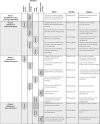Development of a standard set of key work-related outcomes for use in practice for patients with cardiovascular disease: a modified Delphi study
- PMID: 39692809
- PMCID: PMC11655757
- DOI: 10.1186/s41687-024-00825-6
Development of a standard set of key work-related outcomes for use in practice for patients with cardiovascular disease: a modified Delphi study
Abstract
Background: To facilitate the maintenance or resumption of participation in work for patients with cardiovascular disease (CVD), there is a need for high-quality work-focused healthcare. According to the concept of value-based healthcare, quality of care can be enhanced by understanding the outcomes that matter most to patients. However, a major challenge in assessing quality of work-focused healthcare in practice is the lack of consensus on which work-related outcomes should be measured.
Objective: The objective of this study was to identify a standard set of key work-related outcomes for patients with CVD to be used in practice of work-focused healthcare in the Netherlands, including standardised outcome measures and associated case mix factors. This standard set is intended to assist occupational and other health professionals in delivering work-focused healthcare that meets a patient's individual needs regarding work participation, and to enhance patients' engagement in their own work-focused care process.
Methods: A 2-round RAND-modified Delphi process was conducted. The process included literature searches, consecutive research team meetings, and several meetings and rounds of voting by a working group. The working group consisted of patients with CVD (n = 6) and health professionals representing different stakeholders (n = 11) involved in work-focused healthcare for this patient population in the Netherlands. Consensus was reached over four phases: (1) establishing the scope of the standard set and defining the population, (2) prioritising and defining the outcome domains, (3) selecting the outcome measures for the most important domains, including clinical data and patient-reported data, and (4) selecting and defining case mix factors.
Results: A 23-item patient-reported questionnaire was developed, called the Value@WORK-Q23, including questions on nine work-related outcome domains considered most important for patients with CVD: (1) work participation, (2) physical work ability, (3) mental work ability, (4) suitable work, (5) support from the work environment, (6) flexibility of the work environment, (7) communication with the patient, (8) person-centredness, and (9) interdisciplinary communication. In addition, nine case mix variables was selected, comprising demographic-, disease-, and work factors.
Conclusions: The Value@WORK-Q23 provides guidance on measuring the most important work-related outcomes for patients with CVD. Using this work-related set in practice, in addition to existing disease-specific standard sets for CVD may facilitate the provision of high-value work-focused healthcare for this patient population.
WHY?: People with heart disease often need help to stay at work or return to work. To provide the best care, it’s important to know what work-related outcomes matter most to these patients. However, there’s no agreement on which outcomes to measure. WHAT WAS THE GOAL?: This study aimed to create a standard set of important work-related outcomes for heart disease patients in the Netherlands. This set will help health professionals provide better, personalized care and involve patients more in their own care. HOW?: The study used a structured process involving literature reviews, team meetings, and multiple rounds of discussions and voting with a group of patients and health professionals. The group included 6 patients with heart disease and 11 health professionals from various fields. WHAT DID WE FIND?: The study developed a 23-question survey (the Value@WORK-Q23) for patients, covering nine key areas: work participation, physical and mental work ability, suitable work, support and flexibility at work, communication with the patient, person-centred care, and teamwork among health professionals. It also identified nine factors that could affect these outcomes, such as demographics, disease specifics, and work conditions. CONCLUSION?: This new survey helps measuring the most important work-related outcomes for heart disease patients. Using this survey alongside existing heart disease care standards can improve the quality of work-focused healthcare for these patients.
Keywords: Cardiovascular diseases; Interdisciplinary communication; Occupational health; Patient preference; Patient-centred care; Patient-reported outcome measures; Return to work; Value-based healthcare; Work engagement; Workload.
© 2024. The Author(s).
Conflict of interest statement
Declarations. Ethics approval and consent to participate: The study is conducted according to the principles of the Declaration of Helsinki. The Medical Ethics Committee of the Amsterdam University Medical Centre gave ethical approval for the study. The same committee declared that no comprehensive ethical review was needed for this qualitative study, as the Medical Research Involving Human Subjects Act did not apply to this study (Reference number: W22_304 # 22.382). Written informed consent was obtained from all individual participants included in the study. Consent for publication: Not applicable. Competing interests: The authors declare that they have no competing interests.
Figures
References
-
- Harris RE (2019) Epidemiology of chronic disease: global perspectives. Jones & Bartlett Learning
-
- Boot CR, Deeg DJ, Abma T et al (2014) Predictors of having paid work in older workers with and without chronic disease: a 3-year prospective cohort study. J Occup Rehabil 24:563–572 - PubMed
-
- Dekkers-Sánchez PM, Wind H, Sluiter JK, Frings-Dresen MH (2010) A qualitative study of perpetuating factors for long-term sick leave and promoting factors for return to work: chronic work disabled patients in their own words. J Rehabil Med 42(6):544–552 - PubMed
-
- Pinto N, Shah P, Haluska B et al (2012) Return to work after coronary artery bypass in patients aged under 50 years. Asian Cardiovasc Thorac Annals 20(4):387–391 - PubMed
MeSH terms
Grants and funding
LinkOut - more resources
Full Text Sources



